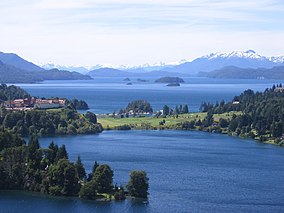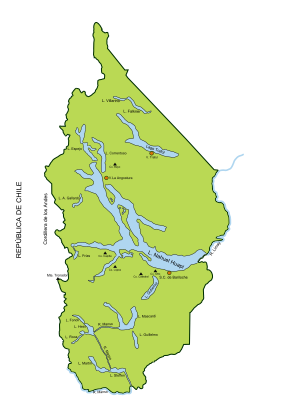Nahuel Huapi National Park
| Nahuel Huapi National Park Parque Nacional Nahuel Huapi |
|
|---|---|
|
IUCN category II (national park)
|
|

Nahuel Huapi National Park
|
|
| Location of Nahuel Huapi Bariloche | |
| Location | Río Negro and Neuquén provinces, Argentina |
| Nearest city | San Carlos de Bariloche and Villa La Angostura |
| Coordinates | 41°00′S 71°30′W / 41.000°S 71.500°WCoordinates: 41°00′S 71°30′W / 41.000°S 71.500°W |
| Area | 7,050 km2 (2,720 sq mi) |
| Established | 1934 |
| Governing body | Administración de Parques Nacionales |
Nahuel Huapi National Park (Spanish: Parque Nacional Nahuel Huapi) is the oldest national park in Argentina, established in 1934. It surrounds Nahuel Huapi Lake in the foothills of the Patagonian Andes. The largest of the national parks in the region, it has an area of 7,050 km2 (2,720 sq mi), or nearly 2 million acres. Its landscapes represent the north Patagonian Andean Zone consisting of three types, namely, the Altoandino (with perpetual snow above an altitude of 1,600 metres (5,200 ft)), the Andino-Patagónico (in the lower reaches of the hills) and the Patagonian steppe. It also represents small parts of the Valdivian Rainforest.
The park and the reserve lie at an altitude of 720–3,574 metres (2,362–11,726 ft), and are designated under IUCN management categories II (National Park) and IV (Management Reserve). The park is completely protected while the reserve is partially protected. The national park is dominated by the high mountain chain of the Andes, many lakes, rapid rivers, waterfalls, snow-clad peaks, glaciers and extensive forests. It is bordered by Chile on its western side.
The park derives its name from the lake which it surrounds, namely the "Nahuel Huapi". In the Mapuche language, nahuel means "jaguar" and huapi means "island".
The earliest discovery of Nahuel Huapi by the non-indigenous peoples is linked to the conquest of Chile. In the summer of 1552–1553, the Governor of Chile Pedro de Valdivia sent Francisco de Villagra to explore the area east of the Andes at the latitudes of the city of Valdivia. Francisco de Villagra crossed the Andes through Mamuil Malal Pass and headed south until reaching Limay River in the vicinity of Nahuel Huapi Lake.
...
Wikipedia

